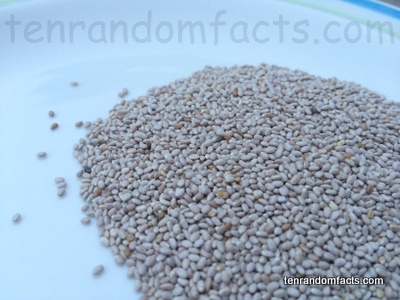Teensy little chia seeds.
- Chia seeds are generally small ovular shaped seeds that are brown, black, grey or white in colour.
- Chia seeds are said to have the most omega 3, fibre and protein of all plant based food, and are also a good source of manganese, phosphorous, and calcium.
- The scientific name of chia seeds is salvia hispanica, and they grow on a blue, purple or white flowering herb from the family of Lamiaceae, which is the family of mint.
- Chia seeds are a traditional ingredient that comes from Mexico and Guatemala, where the plant is native, and in the south west of the United States they are also commonly consumed.
- It is suggested that a small quantity, a tablespoon for an adult and a teaspoon for a child, of chia seeds be eaten each day, because of their source of nutrients.
- The word ‘Chia’ comes from the native Mexican language, from the Nahuatl word ‘chian’, which means ‘oily’.
- Chia can be eaten whole in its raw form or milled, or can be added to foods such as bread, drinks, cereals, muesli bars, baked goods, or yoghurt.
- Chia seeds do not have much flavour so they do not change the flavour of foods that they are combined with.
- Chia seeds are 1 millimetre (0.04inches) in diameter but the chia herb grows to 1 metre (3.3 feet) in height.
- Chia seeds can be used as an egg replacement, as the seeds form a gel-like substance which thicken and combine with other ingredients.
Bibliography:
Salvia Hispanica, 2013, Wikipedia, <http://en.wikipedia.org/wiki/Salvia_hispanica>
Seeds of Goodness, 2013, Life & Style, <http://www.smh.com.au/lifestyle/diet-and-fitness/blogs/chew-on-this/seeds-of-goodness-20130429-2inue.html>







